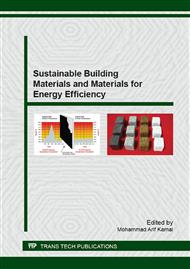p.38
p.51
p.71
p.82
p.91
p.105
p.114
p.122
p.131
The Influence of Dredged of Natural Waste on Shrinkage Behavior of Self Compacting Concrete for Achieving Environmental Sustainability
Abstract:
Every year, millions of cube meters are dredged from dams and restraints as an entertaining and prevention procedure all over the world. These dredged sediments are considered as natural waste leading to an environmental, ecological and even an economical problem in their processing and deposing.Nevertheless, in the context of the sustainable development policy, a way of management is opened aiming to the valorization of sediments as a building material and particularly as a new binder that can be industrially exploited and that improve the physical, chemical and mechanical characteristics of the concrete.This study is a part of the research works realized in the civil engineering department at the university of Mostaganem (Algeria), on the impact of the dredged mud of Fergoug dam on the behaviour of self-consolidating concrete in fresh and hardened state , such as the mechanical performance of SCC and its impact on the differed deformations (shrinkage). The work aims to valorize this mud in SCC and to show eventual interactions between constituents. The results obtained presents a good perspectives in order to perform SCC based in caclined mud.
Info:
Periodical:
Pages:
91-104
Citation:
Online since:
July 2015
Authors:
Keywords:
Price:
Сopyright:
© 2015 Trans Tech Publications Ltd. All Rights Reserved
Share:
Citation:


